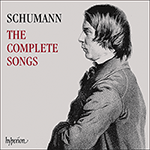
Welcome to Hyperion Records, a British classical label devoted to presenting high-quality recordings of music of all styles and from all periods from the twelfth century to the twenty-first.
Hyperion offers both CDs, and downloads in a number of formats. The site is also available in several languages.
Please use the dropdown buttons to set your preferred options, or use the checkbox to accept the defaults.

It is significant that once he had the energy to contemplate composition, his interests should have turned to another biographical song-cycle. Like Elisabeth Kulmann, Mary Stuart was a tragic figure whose poetry enabled her to speak in her own words; for her supporters she was a martyr, to her enemies an adulteress and murderer. Even after a quarter of a century these camps tended to divide along Catholic and Protestant lines. Could the Queen of Scots be better understood, even redeemed, through Schumann’s musical intervention? He had done his best to make the world aware of the sad story of Elisabeth Kulmann; here he was counsel for the defence for a more famous plaintiff. As a critic he had done so much to welcome Brahms, and many others, into the musical world; it seems that he still felt the need to champion those he thought deserving of his support.
And now from Elisabeth to Mary, with an off-stage role for another less angelic Elizabeth, the Queen of England. (The linking of these names would not have been lost on Schumann, always aware of such strange coincidences.) Schiller’s play Maria Stuart, for all its historical inaccuracies, had made Mary Stuart well enough known as a larger-than-life figure, but Schumann’s way of coming to her rescue was low-key. The cycle, in four of its five episodes, is lacking in overt histrionics and melodrama, and that is perhaps one of its strengths. Schumann succeeded in introducing Mary Stuart into the world of song, and with much greater success than anything achieved by Wagner with his scena entitled Les adieux de Marie Stuart (Béranger, 1840), and even Donizetti in his opera (Maria Stuarda, 1835) based on Schiller. The combination of history and understated pathos has held the recital stage with increasing regularity and conviction.
The span of the cycle is twenty-six years in a woman’s life – many more than that of Frauenliebe und -leben. There is no reference here to love between man and woman, nor to any of the Queen’s three husbands, source of the controversy surrounding her life, as well as of the accusations against her. Instead we see a young girl devoted to her adopted land of France, a young mother concerned for the legacy of her son, a proud imprisoned queen forced to write a pleading letter, the same prisoner some years later renouncing hope in life and, finally, praying before a fearful death. This is certainly an extraordinary Frauenleben expunged of the Liebe that was at the heart of Mary Stuart’s tragedy.
Schumann expected his public to know the life story of Mary Stuart, making sense of the biographical gaps. Today’s listener is probably equally well-informed. I apologise for the necessary abridgements and simplifications in the following chronology:
Mary Stuart was born in Linlithgow on December 8, 1542. The death of her father, King James V of Scotland, left her Queen of Scotland at the age of six days. She was sent to France when she was five, and she was brought up at the court of King Henri II. She was groomed for marriage to the Dauphin and, on the accession of François II in 1559, became, very briefly, the Queen of France, Scotland and England (the latter title claimed on her behalf because of the technical illegitimacy of Elizabeth Tudor). The death of the young and sickly François in 1560 left her a widow at eighteen and made her superfluous to the political plans of her powerful uncles, the Ducs de Guise. The Queen Mother, Catherine de Médici, was hostile to her and, although Mary wished to stay quietly in France, she was sent back to Scotland at one of the most turbulent moments in its history. In a state of uneasy truce with England, it was a land ravaged by religious strife. The Queen’s own Catholicism assorted ill with the country’s predominant Protestantism and its formidable spokesman John Knox. In comparison to life in the châteaux of the Loire valley, life in Scotland offered comparatively primitive living conditions, an immoderate climate, and much political and personal danger. Mary set sail from France for Scotland in August 1561. She was five months from her nineteenth birthday.
from notes by Graham Johnson © 1999
extrait des notes rédigées par Graham Johnson © 2010
Français: Marie-Stella Pâris
aus dem Begleittext von Graham Johnson © 2010
Deutsch: Henning Weber
 Schumann: The Complete Songs Schumann: The Complete SongsSchumann’s songs are among the greatest musical achievements of the nineteeth century, and this marvellous collection comprises Schumann’s complete songs, presented for the first time in their chronological sequence of composition, with complete s ...» More |

